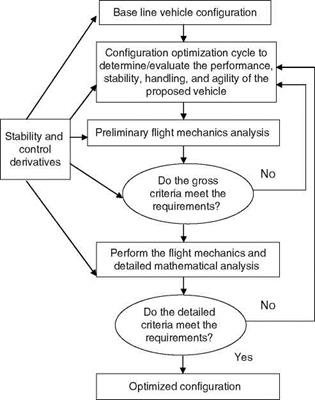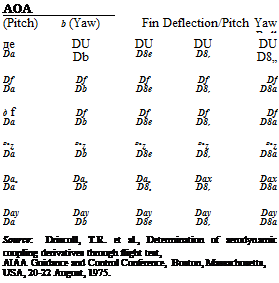As we have seen earlier, aerodynamic forces and moments are numerically expressed in a Taylor’s series expansion of the instantaneous numerical values of the aircraft variables. Specifically, the aerodynamic forces and moments (in fact the aerodynamic coefficients) can be expressed as functions of Mach number M, engine thrust FT, and other aircraft motion and control variables a, b, p, q, r, f, U, 8e, 8a, and 8r. A complete set of aerodynamic coefficients can be represented as [11]
The forces acting on an aircraft are also expressed in terms of lift and drag: the lift force acts normal to the velocity vector V, and the drag force acts in the direction opposite to V. The nondimensional coefficients of lift and drag are denoted by CL and CD. Due to disposition of forces in x and z directions, it is required to resolve the relevant coefficients in the following way (see Exercise 4.4):
 Cx = CL sin a — CD cos a Cz = — (CL cos a + CD sin a)
Cx = CL sin a — CD cos a Cz = — (CL cos a + CD sin a)
Here, the effect of AOSS is neglected. If AOA is small we can further simplify these equations as
Cx = Cia — Cd Cz = —(Ci + CDa)
If AOA is zero or negligibly small, then we get
Cx = CD Cz = — Cl
This shows the straightforward relations between the axial force coefficients and the drag and lift coefficients. Further, we get

 CL = — Cz cos a + CX sin a CD = — CX cos a — Cz sin a
CL = — Cz cos a + CX sin a CD = — CX cos a — Cz sin a
And in terms of several independent variables,
CD = CD0 + CD„a + CDq 2v + CooPe + C°mM + CDftFT CL = CL0 + CL„a + CLq 2V + CL>ede + CLmM + CLft FT
To account for nonlinear and unsteady aerodynamic effects, higher-order derivatives and downwash effects should be included. Also, some additional derivatives can be included to account for aerodynamic cross-coupling effects:
However, the model of Equation 4.50 is quite complex and it will be difficult to determine the additional aerodynamic derivatives from flight test data of an aircraft. When the change in airspeed is not significant during the flight maneuver, the forces X, Y, and Z and the moments L, M, and N can be expanded in terms of the dimensional derivatives rather than nondimensional derivatives for parameter estimation. Let us derive these expressions. Starting from Equation 4.50, considering only three important terms and substituting the formula for NDADs (in terms of the dimensional derivatives) from Table 4.3, we obtain

 qSc pSUc"~rv~~ ‘ pSUc2 ^ 1 ‘ ‘ pSU2c
qSc pSUc"~rv~~ ‘ pSUc2 ^ 1 ‘ ‘ pSU2c
Canceling out the common terms on both the sides we get
M = Iy(Mww + Mqq + MSe8e)
Substituting the defining terms for the dimensional derivatives from Table 4.3, we obtain
 дМ дМ дМ
дМ дМ дМ
~@www + ~dqq + dde d
expressed in terms of the corresponding dimensional derivatives (with certain simple assumptions) as follows:
X m(XuU ^ XwW ^ Xqq ^ X8e8e)
Y — m(Yvv + Ypp + Ygq + Yrr + YSa 8a + YSr 8r)
Z m(ZuU ^ ZwW ^ Zqq ^ Z8e8e)
(4.52)
L — Ix(Lvv Lpp Lqq Lrr L8a8a + L8r8r)
M — Iy(MuU + MwW + Mqq + Mde8e)
N — Iz(NvV + NpP + Nqq + Nrr + Ns, 8 a + Ndr 8r)
Starting from the natural phenomenon that an airplane experiences aerodynamic (airflow/interactions) forces and moments in flight, we have come to gradually appreciate the concept of the ACDs, which form the key elements in understanding the flight-dynamic responses of an aircraft. Aerodynamic coefficients can (1) also be expressed in terms of derivatives due to change in forward speed, e. g., CL, CD, Cz, and Cm, (2) use higher-order derivatives (e. g., Cx 2, Cz 2, and Cm 2) to account for nonlinear effects, and (3) use CLa and Cma derivatives to account for unsteady aerodynamic effects. The choice is problem-specific. Some simple and moderately complicated forms are used in parameter estimation in Chapter 9.
EPILOGUE
The concept of aerodynamic derivatives is central to flight mechanics modeling and analysis and addresses the microlevel behavior of atmospheric vehicles. The concept of stability derivatives to represent aerodynamic forces and moments was introduced by Bryan [1]. A very systematic way of defining the derivatives and a detailed explanation of longitudinal and lateral-directional parameters/derivatives and their origins are treated in Ref. [2]. Aerodynamic derivatives play a very important role in the design and modification of a vehicle’s configuration and development of flight control laws. In addition, determination of these derivatives from flight test data sheds considerable light on the actual behavior of the vehicle and helps in the validation of the aero database (predictions based on analytical/WTs sources) [5,11]. In Ref. [12] airplane stability and control are viewed as an applied science and that it could benefit from several related fields.
![]() U = u0 + u V = v0 + v W = w0 + w
U = u0 + u V = v0 + v W = w0 + w













 Changes in Variables
Changes in Variables

